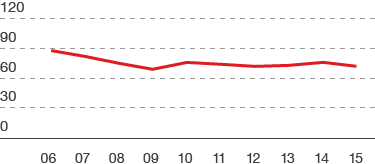Greenhouse gas emissions
Direct greenhouse gas emissions
million tonnes CO2 equivalent

The direct GHG emissions from facilities that we operate were 72 million tonnes on a CO2-equivalent basis in 2015, down from 76 million tonnes of CO2 equivalent in 2014.
We have changed our reporting methodology to align with the Fourth Assessment Report of the Intergovernmental Panel on Climate Change. This has involved updating the way we calculate the global warming potential (GWP) of the greenhouse gases we emit. GWP compares the impact of emissions from greenhouse gases with the impact of emissions from the equivalent amount of CO2. This update has increased our reported GHG emissions (on a CO2-equivalent basis) by around 0.5 million tonnes.
The reasons for our overall decrease in GHG emissions were as follows:
- divestments, including unconventional assets in North America, some operations in Nigeria and the Geelong refinery in Australia;
- operational improvements across many assets;
- overall reduction in flaring (see Flaring);
- start-up of Quest CCS in Canada’s oil sands (see Carbon capture and storage); and
- shutdown of multiple units at our Moerdijk chemical plant in the Netherlands.
Around 45% of our GHG emissions came from the refineries and chemical plants in our Downstream business. The production of oil, gas and gas-to-liquids products in our Upstream business accounted for around 50% of our GHG emissions, and our shipping activities for less than 3%. We continue to work on improving operational performance and energy efficiency to reduce GHG emissions.
The indirect GHG emissions from the energy that we purchased (electricity, heat and steam)decreased to 9 million tonnes on a CO2-equivalent basis in 2015, from 10 million tonnes in 2014. These emissions were calculated using a market-based approach, as defined by the World Resources Institute GHG Protocol. We estimate that the CO2 emissions from the use of our refinery and natural gas products were around 560 million tonnes in 2015.
